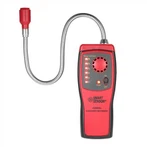The difference between multimeter testing and oscilloscope testing
Multimeters and oscilloscopes are commonly used tools
Multimeters and oscilloscopes are all too familiar to electronic engineers. It can be said that it is an essential tool for research and development, debugging, and maintenance. Of course, the functions of a multimeter and an oscilloscope are completely different.
Multimeter
There are two types of multimeter: pointer type and digital type; The pointer type has basically been phased out, and now digital multimeter is mostly used.
A multimeter can be used to measure resistance, AC and DC voltage, AC and DC current, diodes, capacitors, frequency, etc. The multimeter is simple and easy to use. As long as the gear is set to the desired functional gear for measurement, the measurement can be carried out.
When using a multimeter to measure current, special attention should be paid. To measure current, the multimeter needs to be connected in series to the circuit, and the red probe needs to be inserted into the appropriate range socket. If the current exceeds the range, it will burn out the fuse of the multimeter.
oscilloscope
An oscilloscope and a multimeter are different, and a multimeter can only display the measured values. An oscilloscope can quickly and continuously measure signals, plot them into curves, and display them on the screen.
The application of oscilloscopes is very extensive. Signals that cannot be seen by the naked eye can be converted into images. We can analyze the changes in various signals and data based on the measured signal waveform.
The oscilloscope has many functions and menus, and requires a certain basic knowledge to be used.
Multimeters are divided into two types: analog and digital.
The analog meter pointer swings flexibly, making it easier to determine changes in the circuit.
oscilloscope
The multimeter intelligently measures DC signals and low-frequency pure AC signals more accurately. For most AC and digital signals, an oscilloscope can only be used to detect them. Due to the oscilloscope's ability to display various signal waveforms detected in electronic circuits on the oscilloscope tube, it enables people to accurately determine whether the circuit is normal during equipment maintenance and circuit debugging.
In circuits, especially weak electronic circuits, electrical signals may be complex, random, and transient. In this case, an oscilloscope can be used to analyze the characteristics of the signal and estimate its electrical parameters. A multimeter can only measure typical steady-state electrical signal parameters, which is not convenient for measuring and analyzing complex electrical signal parameters. A multimeter is suitable for measuring both traditional strong current lines and certain parameters in weak current lines. Oscilloscopes are widely used in electronic circuits, but are less suitable for strong current circuits.
It goes without saying that the various functions of a multimeter are well-known, but when measuring signals, a multimeter can only measure a rough voltage to preliminarily determine and guess whether there is a fault at the measurement point, which cannot be accurately determined. However, an oscilloscope can visually see the waveform of the measurement point, whether it is deformed or lost signal, and can accurately determine whether there is a fault or distortion, such as the scanning waveform of electronic tube televisions, Whether the waveform of the TV signal is distorted or lost in various signal amplification circuits can be visually observed to see if there are any problems.






